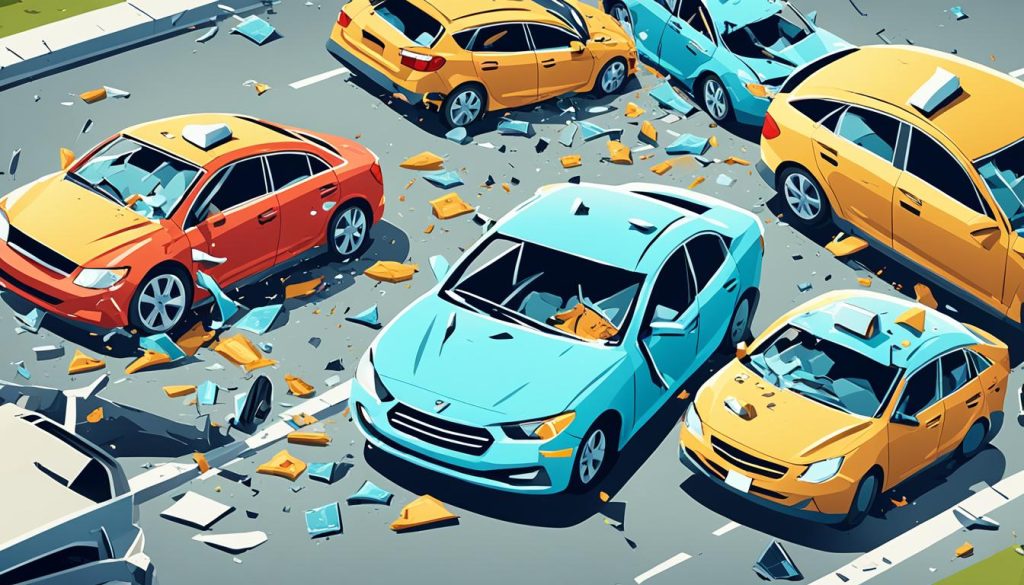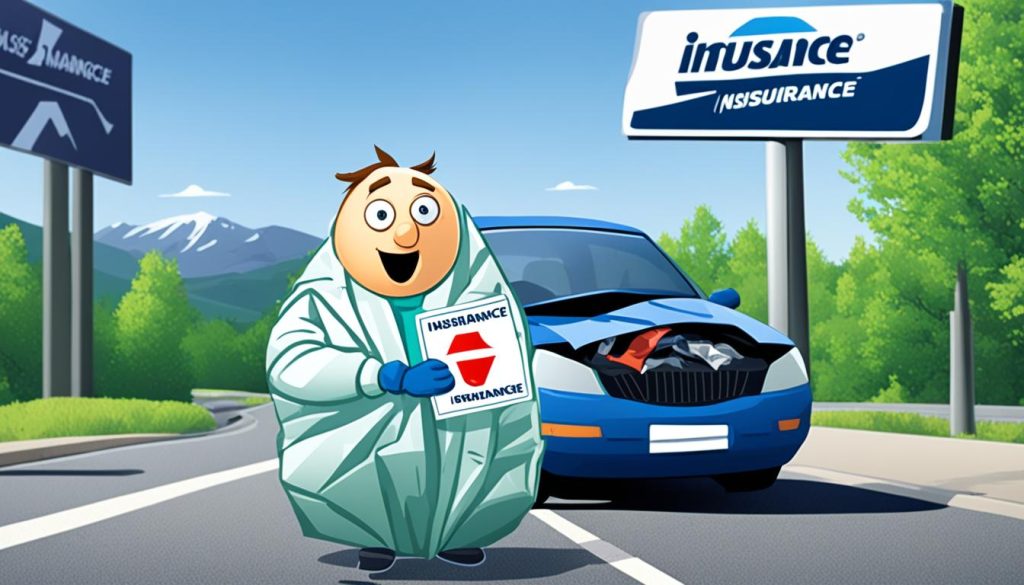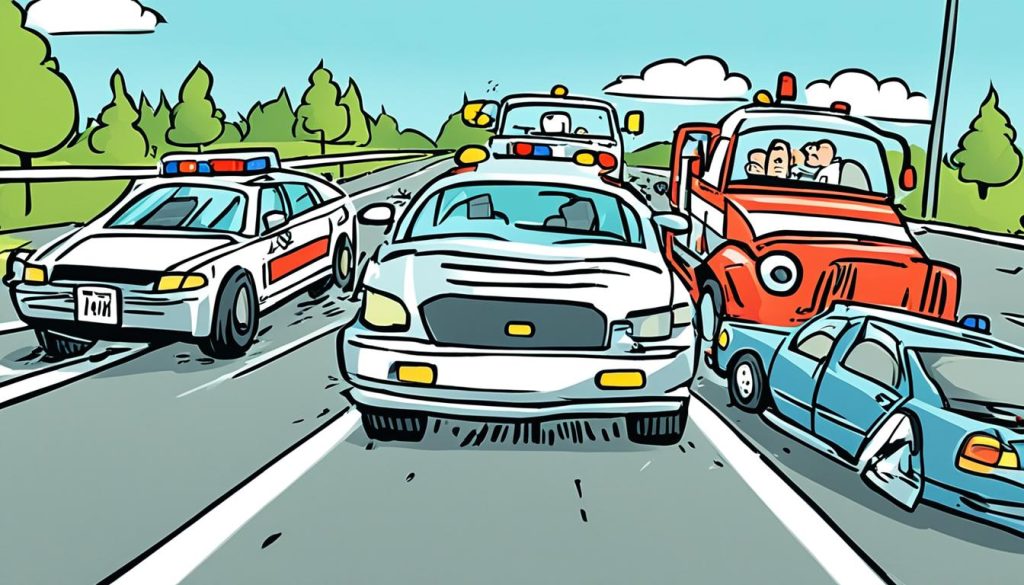Driving can be unpredictable, and car accidents can happen anytime. Knowing the essential steps to take after a collision is crucial. This article will guide you through the key actions to take following a car accident. By being prepared and taking the right steps, you can navigate the aftermath of a car accident with confidence.
Remain Calm and Ensure Everyone’s Safety
The first and most important step after a car accident is to remain calm and assess the situation1. It is crucial to have an emergency kit that includes flares or reflective triangles in case of an accident to effectively direct traffic1. Your primary concern should be the well-being of all parties involved, including yourself, the other driver, and any passengers.
Check for Injuries
Carefully check yourself and any other individuals for injuries. If someone is injured, do not attempt to move them unless there is an immediate danger, such as a fire or the risk of further collisions. Instead, call emergency services immediately and provide the necessary assistance, such as applying first aid or keeping the injured person still and comfortable.
Move Vehicles to a Safe Location
If possible, move the vehicles involved in the accident to a safe location, such as a nearby parking lot or side street, to avoid further collisions1. Turn on your hazard lights and set up flares or reflective triangles to alert other drivers to the situation. This will help prevent additional accidents and ensure the safety of everyone involved.
Notify Authorities and Obtain Police Report
2 Illinois law requires the driver of any vehicle involved in an accident to provide reasonable assistance to any injured party, including calling for help or carrying the injured person to a medical facility if possible2. It’s advised to promptly report the accident to law enforcement for documentational purposes and to assist in insurance claims. Police can create an official report of the accident.
Exchange Information and Document the Scene
1 Post-accident, in most cases, individuals should exchange information with the other driver involved in the accident, including names, insurance information, phone numbers, vehicle make and model, and witness contact information1. Take photos of the damage to both vehicles, the accident scene, and any injuries sustained. This documentation will be crucial for the insurance claims process and any potential legal proceedings.
Assess Damage and File Insurance Claim
1 The decision to file an insurance claim post-accident depends on several factors such as fault, extent of vehicle damage, injuries sustained, and both your and the other driver’s insurance coverage1. After filing an insurance claim, individuals should be prepared to pay their policy’s deductible before any repairs or claims are processed by the insurance company.
Track Repairs and Expenses
Keep detailed records of all expenses related to the accident, including repair costs, rental car fees, and any medical bills. Monitor the progress of the repairs and ensure that the work is being done correctly and to your satisfaction. This documentation will be essential for the insurance claims process and any potential disputes.
Key Takeaways
- Remain calm and ensure the safety of all parties involved in the accident.
- Check for injuries and call for emergency medical assistance if needed.
- Move vehicles to a safe location and set up flares or reflective triangles to alert other drivers.
- Notify the authorities and obtain an official police report of the accident.
- Exchange information with the other driver and thoroughly document the scene with photos.
Remain Calm and Ensure Everyone’s Safety
After a car accident, things can get really chaotic. It’s key to stay calm and focus on keeping everyone safe. Whiplash can happen hours after the crash and can be serious if not treated.3 So, it’s vital to check the situation out well.
Start by taking a deep breath and checking on everyone at the scene. If someone is hurt, call 911 right away for help. Some injuries might not be obvious at first, so it’s crucial to get medical help quickly.3 Emergency teams are key in giving medical help and managing traffic after a crash.3
Check for Injuries
Look over yourself and others for any signs of injury, like cuts or broken bones. Checking for injuries after a crash is important, including cuts, bruises, concussions, and whiplash, which might not be seen right away.4 If you know how, give first aid. Wait for the emergency team to get there.
Move Vehicles to a Safe Location
If the cars can be moved and it’s safe, move them to a parking lot or side street away from traffic. Clearing the road and moving cars to a safe spot lowers the chance of more accidents and keeps everyone safe.4 Turn on your hazard lights to warn other drivers. Consider using road flares or cones for better visibility.
Staying calm, checking for injuries, moving to a safe spot, turning on hazard lights, and calling the police are key steps after a car accident.534
Notify Authorities and Obtain Police Report
After a car accident, make sure everyone is safe first. Then, call the law enforcement to report the incident6. Even if the crash seems minor, an official police report is key for your insurance claims and legal actions7. Tell the dispatcher about the accident spot, injuries, and cars involved. Be ready to answer the officer’s questions and keep a copy of the police report7.
In places like Wyoming, you must call the police right away if there’s injury, death, or over $1,000 in property damage6. Not reporting such an accident can lead to a big fine or even jail6. Getting the police report might cost about $3.00, and more if you pay with a credit card6.
The police report gives vital info on the car accident steps, like the date, time, and location. It also lists the drivers and passengers, vehicle details, and any citations8. This report is crucial for your insurance claims and legal cases, even if it includes “hearsay”7.
It might take a few weeks for the officer to finish the police report7. Insurance companies will also look into the accident7. Getting advice from a skilled car accident lawyer is wise, no matter the police report’s findings768.
Exchange Information and Document the Scene
After a car accident, it’s key to swap important info with the other driver9. While waiting for the police, get the other driver’s name, contact info, insurance details, and license plate. Also, ask for witness names and phone numbers if there were any. Their stories can help figure out who was at fault9.
Gather Driver and Witness Details
- Get the other driver’s name, contact info, and insurance details
- Ask any witnesses for their names and phone numbers
- Record the license plate numbers of the vehicles involved
Take Photos of Damage and Surroundings
Also, use your camera or smartphone to document the scene well. Capture photos of the vehicle damage, the accident spot, and any signs or road conditions9. This visual proof can greatly help in figuring out who was to blame and backing up your insurance claim9. Remember, taking pictures and swapping info can clear up who was at fault and aid in the claims process9.

The police report is key in figuring out who’s to blame and in the claims process9. In Illinois, you must call the police after a car accident if it’s serious or if there’s over $1,500 in damages10.
| Importance of Documenting the Scene | Impact |
|---|---|
| Clarify fault in the accident | 9 Taking photos and exchanging info can help prove who was at fault. |
| Support insurance claims | 9 With documented evidence, you’re 78% more likely to win your claim. |
| Assist in the claims process | 9 Keeping your accident documents in order can cut insurance claim time by 40%. |
Even in minor accidents with no injuries and little damage, it’s smart to swap info for future claims9. Some insurance companies offer accident forgiveness to avoid rate hikes after an accident9. Also, having uninsured or underinsured motorist coverage can lower costs if hit by an uninsured driver, with some states making this coverage mandatory for drivers9.
“Documenting the accident scene with photos and exchanging information can make all the difference in the claims process.”
By doing these steps, you’ll have the right documents and evidence for your insurance claim. This can improve your case’s outcome11. It’s also wise to talk to a personal injury lawyer, as having one can increase your chances of getting compensation by 65%11.
car accident steps, personal injury, accident procedure
After a car accident, it can feel overwhelming. But knowing the right steps can help protect your rights. From staying calm to gathering evidence, each step is key for your claim. These steps can help you get the insurance claim you need and seek legal help if needed.
- Remain Calm and Ensure Everyone’s Safety: Stay calm and check on everyone’s well-being. Make sure any injuries get attention. Move vehicles to a safe spot if you can, to avoid more accidents12.
- Notify Authorities and Obtain a Police Report: Always call the police, even if it’s a minor accident. A police report is vital for your claim and protects your rights12.
- Exchange Information and Document the Scene: Get details from the other driver, like their name and insurance info. Take photos of the scene and any vehicle damage to document what happened12.
- File an Insurance Claim: Tell your insurance company about the accident right away. Give them all the details and documents you have12.
- Understand Your Legal Rights: In some places, like Tennessee, the accident’s fault can affect who pays for damages. A lawyer can help you understand your rights and protect them.
- Track Repairs and Expenses: Keep track of all costs from the accident, like repair bills and medical expenses. This info is important for your claim and legal actions12.
Following these steps can help you manage the situation well. Remember, your safety is most important. Getting professional help can guide you through the insurance claims process and protect your rights.
| Key Considerations | Details |
|---|---|
| Reporting Requirements | In California, report accidents to the Department of Motor Vehicles if someone got hurt or damage is over $750.00 within 10 days13. |
| Insurance Company Timelines | Insurance companies usually contact you after reporting a claim, but it can take up to 15 days13. |
| Damage Evaluation | Insurance looks at damage by checking estimates and may ask for more costs later13. |
| Actual Cash Value (ACV) | In California, ACV means the car’s market value, based on what buyers and sellers think it’s worth13. |
| Appraisal Provisions | Most car insurance policies let you and the other party ask for an appraisal if you disagree on a total loss13. |
| Remaining Loan Balance | If a car is damaged or stolen, the borrower is usually responsible for the loan balance. “Gap” insurance can cover this13. |
| Rental Car Coverage | If your policy includes rental car coverage, insurance will pay for a rental while yours is fixed, up to a daily limit and for a certain number of days13. |
| Salvage Value | Salvage value is what a damaged car is worth if it’s considered a total loss13. |
| Subrogation | Subrogation lets insurance companies get back money they paid to you from the person at fault, minus your deductible13. |
Handling car accident claims can be tough, but knowing what to do can protect your interests. Always put your safety first, document everything, and get professional advice if you need it. These steps can reduce the stress of an accident and help you focus on getting better.
“It’s essential to remain calm and focused after a car accident, as the actions you take in the immediate aftermath can have a significant impact on the claims process and your ability to recover damages.”
Dealing with a car accident’s aftermath can be tough. But understanding key steps can help you manage it well and protect your rights. From safety to filing claims, each action is crucial for a fair outcome. Always remember, your health is the most important thing. Getting professional advice can make navigating the claims process easier.
Assess Damage and File Insurance Claim
After a car accident, it’s key to check the damage and decide if you need to file an insurance claim. This choice depends on repair costs and your deductible14.
If the damage is minor and repair costs are less than your deductible, you might not file a claim to avoid higher insurance rates15. But, for big damage or if you weren’t at fault, filing a claim is usually a good idea. Your insurance can help you with the claim process and cover accident costs14.
Determine if Filing a Claim is Necessary
Think about these points when deciding on a claim. Insurance companies might offer less if you wait too long to file a claim14. Adjusters use a formula to value claims, considering medical costs, lost wages, and more14.
The settlement amount depends on the adjuster’s fault assessment, your policy limits, and the strength of a lawsuit14. Adjusters often start with a low offer to leave room for negotiation14. Accepting their first offer might stop you from claiming more costs later14.
Talking to a personal injury lawyer might get you a better settlement because they know how to value claims and negotiate14. Having a lawyer from the start can help avoid mistakes and get a fair settlement14.

Some people might choose to pay for repairs themselves instead of filing a claim15. But, it’s smart to call your insurance agent and file a claim if the damage is severe or if you got hurt15. Filing a claim can protect you financially by covering damages or injuries from driving15.
Start the claim process at the accident scene by gathering important info, like the other driver’s details and witness contacts15. Don’t admit fault at the scene; insurance companies will decide later15. Having photos and scene info helps when you call your insurance to file a claim15.
Insurance companies let you file claims online or through apps, but calling a rep is also an option to make sure everything is done right15. If your car can’t be driven, the insurer might arrange a tow truck and help with a rental car if you have coverage15. After contacting your insurer, a claims specialist will guide you through the process15.
The specialist will check the damage to see what repairs are needed or if the car is totaled15. Gap insurance and claims for diminished value might apply based on your policy and the accident details15. The insurer will give you a repair estimate, and it’s wise to wait for this before agreeing to repairs15.
Keep following up on your claim and ask for help if you run into problems15. Most states require certain car insurance coverages, and some states cover claims without fault16. If the at-fault driver has no insurance, your policy might cover you, and driving without insurance can lead to serious consequences16.
When filing a claim, you’ll need to give your policy number, accident details, and police report info16. Insurance covers costs until fault is decided, but you might have to use approved shops or pay the difference16. For medical claims, keep and send in medical receipts, and you can file a claim without a police report if you have other evidence16.
File your car insurance claim quickly, as there’s a time limit16. Claims adjusters will look into the accident by reviewing reports, talking to people involved, and visiting the scene to check fault and work with the other insurance company for payment16.
Track Repairs and Expenses
If you’ve filed an insurance claim after a car accident, it’s key to stay involved in the car accident steps and repair process. Keep an eye on the work done on your vehicle to make sure it’s done right and with original parts17. Also, keep detailed records of all expenses, like repair costs, rental car fees, and medical bills. This info is crucial for your insurance claims and making sure you get back what you paid out-of-pocket17.
Monitor Repair Process
Be proactive in the repair process by checking the work’s progress and quality. Talk to the repair shop to ensure they use original parts and meet your standards17. This way, you keep control over the repair process and can fix any problems early.
Keep Records of Costs and Appointments
Document all expenses related to the accident, like repair estimates, invoices, rental car receipts, and medical bills17. This detailed record is key for your insurance claim and getting back what you paid out-of-pocket17. Remember to note all meetings with repair shops, insurance adjusters, and healthcare providers. This info helps back up your claim17.
| Expense Category | Amount |
|---|---|
| Vehicle Repair | $2,500 |
| Rental Car | $500 |
| Medical Bills | $1,200 |
| Total Expenses | $4,200 |
By keeping an eye on the repair process and tracking expenses, you can make the insurance claims process smoother. This helps protect your rights and gets you fair compensation for the accident’s effects17.
Conclusion
By following the steps in this guide, you can handle a car accident’s aftermath with confidence. This protects your rights and financial interests18. In 2021, about 5.4 million people got hurt in car crashes, and some injuries might not show up right away18. Talking to a skilled car accident lawyer can really help, as they can talk to the other driver’s lawyer and make sure you get fair pay for your medical bills, pain, lost wages, and other damages18.
It’s important to know the law, as some states have ‘no-fault’ rules or contributory negligence laws that affect your claim19. You usually have one to three years to file a personal injury claim, and lawyers often work for a share of the settlement19. With a good lawyer and understanding the insurance claims process, you can get a better outcome and reduce the stress from the accident18.
Being ready and taking the right steps can help you recover from an accident smoothly20. Every year, 64,000 people get hurt in car accidents, with 30% needing urgent medical care20. By documenting the incident and getting help from legal and insurance experts, you can protect your rights and get the compensation you deserve182019.
FAQ
What are the most important steps to take after a car accident?
Key steps include staying calm and making sure everyone is safe. Next, call the authorities and get a police report. Then, swap info and document the scene. Finally, file an insurance claim and keep track of repair costs and expenses.
How do I ensure the safety of everyone involved in the accident?
First, check for injuries and call 911 if anyone is hurt. If cars can move, put them in a safe spot. Use hazard lights and road flares to make them more visible and prevent more accidents.
Why is it important to contact the police and get a report?
A police report is crucial for insurance claims and legal matters. Give the dispatcher details about the accident, injuries, and vehicles. This report will document the incident and help figure out who was at fault.
What information should I exchange with the other driver(s) involved?
Swap insurance and contact info with the other driver(s). Also, ask witnesses for their details, as their stories can be important.
How can I document the scene of the accident?
Use your camera or smartphone to take photos of the damage, location, and road signs. This evidence is key in proving fault and supporting your claim.
When should I file an insurance claim after a car accident?
Think about repair costs versus your deductible. If repairs are minor and under your deductible, you might not file a claim to avoid higher insurance rates. But, for big damage or if you weren’t at fault, filing a claim is usually a good idea.
What should I do during the repair process?
Keep an eye on the repair work to make sure it’s done right and with original parts. Also, keep detailed records of all accident-related costs, like repair bills, rental car fees, and medical expenses. These records help support your insurance claim and ensure you get back what you paid out.
Source Links
- What to Do After a Car Accident
- Your Guide to Auto Accidents
- 10 Crucial Steps to Take After a Car Crash! – Kujawski Associates
- Post-Crash Protocol: 9 Essential Steps to Take After a Car Accident
- What Should I Do At The Scene Of A Car Accident?
- How to Get an Accident Report
- Car Accident Police Report: When & How To Get A Report
- What Are Car Accident Police Reports?
- What to Do After a Car Accident
- What to Do After a Car Accident in Chicago | Staver
- What to Do After a Car Accident: Legal Steps for Protecting Your Rights
- 7 Steps To Take After a Car Accident | Bankrate
- So You’ve Had an Accident, What’s Next?
- How Do Insurance Companies Evaluate Personal Injury Claims? – SMS Legal
- Filing a Car Insurance Claim: A Step-by-Step Guide | Bankrate
- Car Accident Insurance Claims Process
- 8 Essential Steps to Follow After a Car Accident
- A Step-by-Step Guide to the Auto Accident Lawsuit Process
- Navigating Car Accident Personal Injury Claims – Katzman & Sugden, LLC
- What to Do After a Car Accident That is Not Your Fault: Step-by-Step Guide

